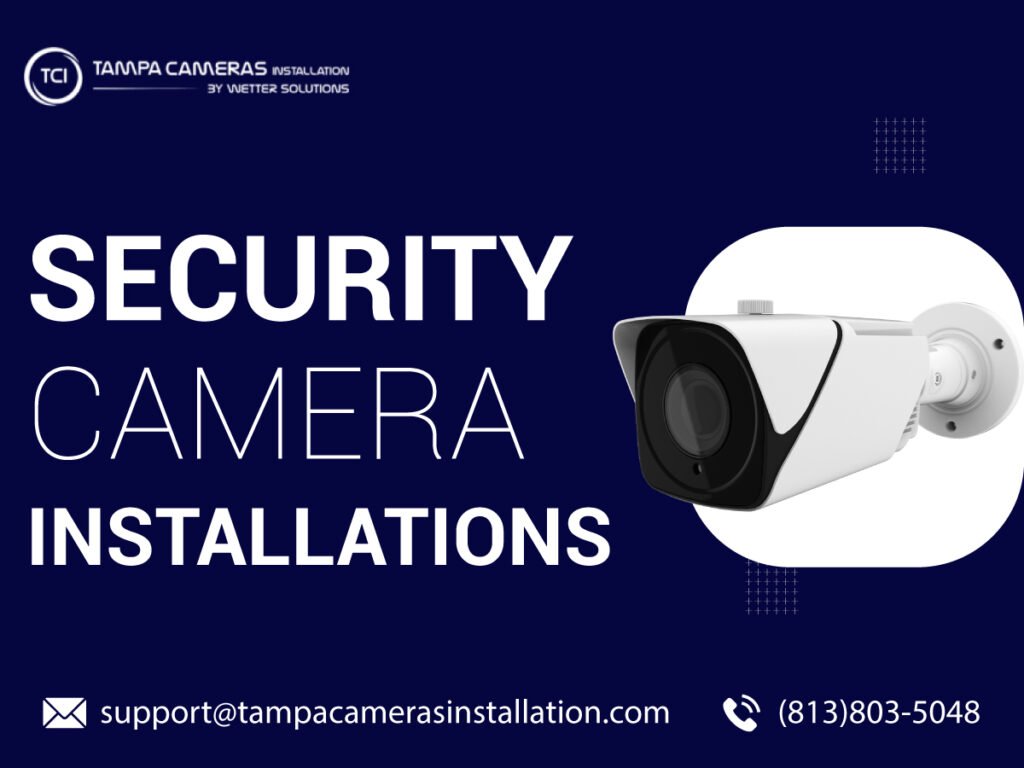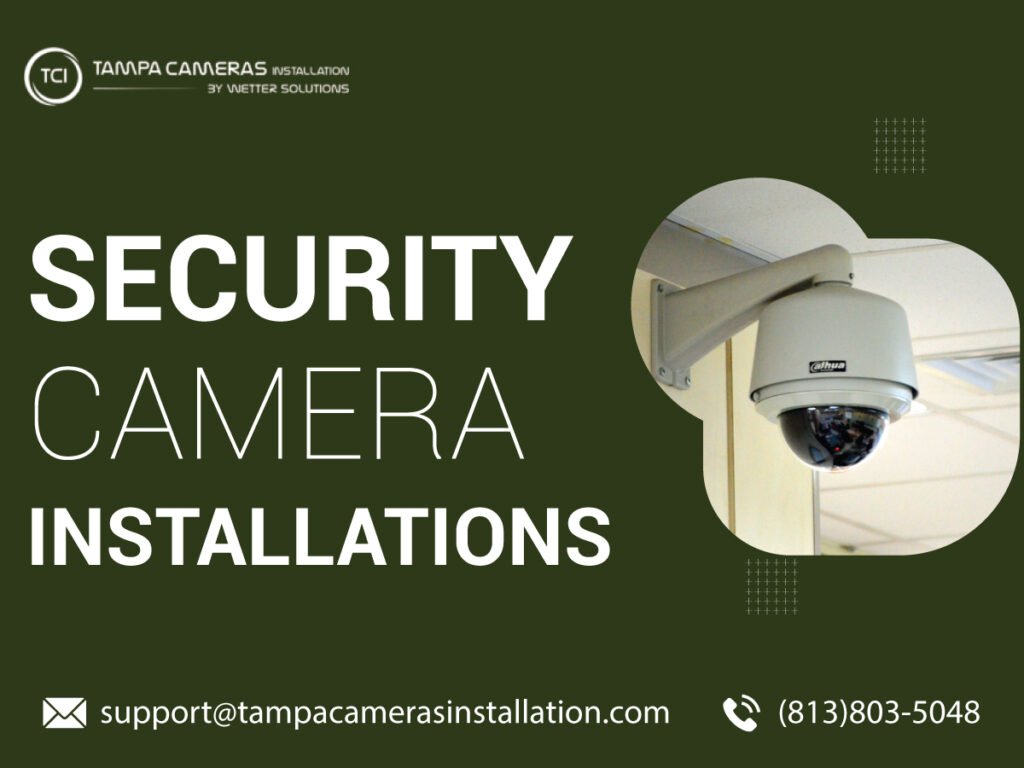Security camera installations involve installing and configuring a video system to monitor and safeguard people, property, and assets. This means choosing, buying, and installing cameras and other equipment and setting up the system to meet specific security needs.
These cameras are available with a range of resolutions and often have a lower resolution than conventional cameras. Additionally, they may be more expensive. Integration with other systems, such as video analytics software, can increase the intelligence of the surveillance system. Thermal cameras provide different information. These cameras should not be utilized as a substitute for visible-light cameras but rather as a complementing technology.
Types of Security Cameras
Security camera installations differ from camera to camera. They come in various shapes, sizes, and capabilities. Understanding the different types of security cameras available is essential when choosing the right security system for your home or business. The following are the main types of security cameras:
Wireless Cameras
Wireless security cameras can broadcast video and audio signals without using cords. They communicate with a wireless network or a central device, such as a DVR or a smartphone, to allow real-time monitoring and remote surveillance.
The advantages of wireless cameras are installation simplicity, positioning versatility, and portability. They may be installed anywhere without the requirement for electrical wiring and can be moved without difficulty. Additionally, wireless cameras offer remote access to live video streams, allowing you to watch your property from anywhere.
Wireless cameras have disadvantages due to the risk of signal interference, the requirement for dependable Wi-Fi access, and the need to routinely change batteries. Access to sophisticated capabilities such as video storage and motion detection may require a subscription to a cloud-based service for some models.
Overall, wireless security and surveillance cameras are practical and adaptable alternatives.
Analogue Surveillance Camera
Analog Cameras have been the most used type of CCTV camera for decades. These cameras capture and transmit video using an analogue signal converted to a digital signal for viewing or recording.
Analogue cameras are connected to a digital video recorder (DVR) or a Video Cassette Recorder to record and store video footage (VCR).
Analog CCTV cameras are renowned for their affordability, dependability, and ease of use. They are suited for essential surveillance of small to medium-sized business buildings. Nevertheless, analogue cameras often have a lower resolution than digital cameras, and video quality may need to improve over long cable connections. Additionally, they require dedicated cabling and power supply, making installation more difficult and expensive.
Digital CCTV cameras offer superior quality, less upkeep and storage space, and better adaptability, rendering analogue CCTV cameras less popular.

IP cameras
IP cameras, often known as digital CCTV cameras, transmit video and audio via a network using digital technologies. They are connected to the internet or a local network and are available remotely for live viewing and recording.
High resolution and image quality are the primary advantages of digital IP cameras. They can produce high-definition video with advanced features like a wide dynamic range and night vision. Additionally, many digital IP cameras feature built-in motion detection and may transmit alerts when motion is detected.
Remote accessibility is an added benefit of digital IP cameras. These cameras are accessible remotely from any Internet-connected location, allowing for real-time monitoring and recording and remote playback. This makes monitoring and checking the property while you are away easy.
Digital IP cameras can also interface with other storage and administration devices, such as NVR (Network Video Recorder) or VMS (Video Management System) (Video Management Software). Due to technical improvements, many digital IP cameras now support advanced features such as facial recognition and object detection.
PTZ camera
The abbreviation PTZ stands for “pan, tilt, and zoom” and refers to a type of CCTV camera whose field of view may be moved and adjusted. Typically, these cameras are installed on a base that permits them to pan, tilt, and zoom. This renders them highly adaptable and helpful for various commercial applications.
PTZ cameras are frequently employed in locations where a fixed-position camera would not give appropriate coverage, such as vast open areas, hallways, or many entryways. They can also monitor specific regions of interest and track moving objects. PTZ cameras are additionally utilized for remote control and Auto tracking. The cameras can be remotely controlled, allowing the operator to change the camera’s field of view without physically relocating it.
Some PTZ cameras also include additional functions, such as preset settings and auto-tracking, allowing the camera to follow a moving object inside its field of view automatically. These capabilities increase the versatility and value of PTZ cameras for commercial surveillance applications.
Infrared cameras
Infrared sensors, commonly referred to as thermal sensors, are a form of CCTV camera that captures images using infrared light. They function by detecting the temperature of objects inside the view area and turning that data into a picture. In various settings, including commercial properties, thermal cameras can be used to identify intruders or monitor the perimeter of a building.
One of the primary advantages of thermal cameras is their ability to see in complete darkness, making them suitable for surveillance in low-light or no-light environments. They can also detect heat signatures through walls, fog, and smoke, making them helpful for search and rescue operations and locating hot areas in industrial buildings.
Installation Process
Security camera installation involves mounting cameras to monitor and secure a specific area. This procedure requires numerous steps, including planning, purchasing the appropriate equipment, mounting the cameras, connecting the cameras to power and the network, and configuring remote viewing. Installation is crucial for assuring the effectiveness and dependability of the surveillance camera system. Proper planning, equipment selection, and installation techniques are required to ensure that the system functions as intended and offers the necessary level of security. Additionally, routine maintenance and upgrades should be undertaken to maintain the system’s functionality and stay up with the most recent technological developments in security cameras. Here is the process:
Planning the Installation: Before installing a CCTV system, it’s essential to plan the installation process carefully. This includes determining the location of the cameras, identifying potential blind spots, and deciding on the number of cameras needed. It’s also essential to assess the infrastructure and determine if additional wiring or cabling is needed. Other considerations include lighting conditions, network connectivity, and the recording equipment required. A thorough planning process can ensure that the CCTV system is installed correctly and provides maximum security coverage.
Selecting the Right Equipment: Choosing the right CCTV equipment is crucial for a successful installation. The type of cameras required depends on the environment and the level of security required. For example, indoor cameras may require different specifications compared to outdoor cameras. Other equipment required includes the DVR or NVR, cabling, and power supplies. It’s essential to select high-quality equipment from reputable manufacturers to ensure the system’s longevity and reliability.
Mounting the Cameras: Once the equipment has been selected, the cameras can be mounted. The cameras should be mounted in a location that provides maximum visibility and security coverage. It’s essential to follow the manufacturer’s guidelines and use the proper mounting hardware to ensure the cameras are securely attached.
Connecting to Power and Network: After mounting the cameras, they need to be connected to power and the network. This includes connecting the cameras to a power source, such as an outlet, and connecting the cameras to the DVR or NVR using the appropriate cabling. The network connection is necessary to enable remote viewing and storing of footage.
Setting up Remote Viewing: The final step is to set up remote viewing capabilities. This allows you to access and view the footage from anywhere, as long as you have an internet connection. This can be done through a web browser or a mobile app, and it is essential to set up proper security measures, such as passwords and firewalls, to protect against unauthorised access.
Maintenance and Upgrades
Maintenance and Upgrades of Security Camera Installations: Keeping your security cameras in good working condition and up-to-date is crucial for the effectiveness of your surveillance system. Regular maintenance and upgrades can fix problems and improve camera performance. Lenses, wiring, and software updates are frequent maintenance duties. More cameras, better equipment, or features like facial recognition or cloud storage may be added. Check it regularly to guarantee your security camera installation is working properly and protecting you. Here is how you can maintain:
Regular Maintenance: A CCTV system needs regular maintenance to perform properly. Clean and tighten loose connections, inspect equipment damage, update software and firmware, and test cameras and displays. Regular maintenance helps find and fix faults before they become more prominent.
Upgrading Equipment: To keep up with CCTV technology, equipment must be upgraded. New cameras, monitors, storage devices, wiring, and software can improve system performance. This ensures the CCTV system meets the organisation’s changing security needs.
Adding Cameras: Adding cameras to a CCTV system can increase coverage and security. New cameras can be deployed in new locations or replace obsolete ones that no longer provide enough protection. The new cameras may be connected to the system for real-time monitoring and recording.
Conclusion
Security camera installations have become increasingly vital in modern life. Due to rising crime and security concerns, businesses and homeowners must secure their property. Security cameras can provide peace of mind, discourage crime, and provide evidence of a break-in. Security cameras should match your property’s needs. Technology has made security cameras cheaper and easier to install, making them available to everyone. We advocate installing a security camera system to protect your home.

